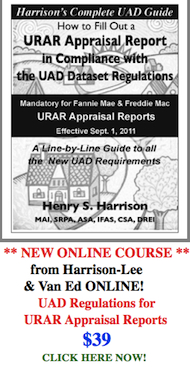Article
How to Appraise in a Declining Market
An Analysis by Henry S. Harrison, MAI, SRPA, ASA of
APB Valuation Advisory #3: Residential Appraising in a Declining Market
The Appraisal Practices Board (APB) of the Appraisal Foundation has just released “APB Valuation Advisory #3 – Residential Appraising in a Declining Market” dated May 7, 2012. This 33 page document is available at the Appraisal Foundation Website: www.appraisalfoundation.org (When you land on their Homepage, single click on the left side column “Appraisal Practices Board (APB)” ; and then single click on “APB Valuation Advisory” and then on “APB Valuation Advisory #3.”)
The most frequent question I’ve received in my “Ask Henry” mailbox over the past few years is “How does an appraiser make an appraisal of a property in a declining market?” The majority of these questions come from residential appraisers and express their confusion as to how to include (or not include) consideration of distressed sales, short sales, foreclosure sales, etc. — and if such comps are to be used, how they should be adjusted. I will address these problems in more detail as I summarize and comment on the eight subjects that make up the Valuation Advisory #3.
I. How Should an Appraiser Define a Declining Market?
Since there is no universally accepted definition of a declining market, it is incumbent upon the appraiser, when they report that the subject property is in a declining market, to include in the appraisal a definition of the term “Declining Market.” Support must be presented that demonstrates that the subject market area fits the provided definition.
For example, you might say: “A declining market is one where the median house prices go down for two consecutive 3-month periods.” To use this definition, you would then have to supply the necessary data about median sale prices in the subject market, showing that they have gone down during the past two 3-month periods. Keep in mind that an appraisal is based on historic information and is not a forecast of future conditions. It is not good appraisal practice to forecast the market direction or trend for the subject market into the future.
There are a variety of national, regional and state databases which produce information to support a market analysis conclusion. The problem with many of them is that they cover areas much larger than the typical market area in which the subject property is located. They also tend to include all types of property in a market area, rather than just the subject property type in its specific market.
In many areas, information from the local MLS system is the easiest to refine to reflect the subject property’s market. It is also possible to extract the sales history of a local market area as reported on Zillow.com and Trulia.com — two major national housing websites. In one rainy afternoon at your computer, using either of these national services, it is possible to extract enough comparable sales data in the subject market area to develop the median house price (using sale price per square foot) for each month or months you wish to use and compare them to each other, to develop a trend. Once you’ve done this, the data can be repeatedly used and updated readily.
III. What Are Some Alternative Value Definitions?
When you are making an appraisal for mortgage lending purposes, you must use the definition that is part of the Fannie Mae/Freddie Mac forms unless the lender/client specifies some other definition, which will probably make the appraisal unusable for mortgage lending purposes. I highly recommend that if you intend to comply with such a lender/client request, you get it in writing. This avoids the lender asking for a “redo” at your expense when it turns out that the appraisal is useless to them and whoever asked for it is long gone.
Valuation Advisory #3 states:
“Clients can stipulate conditions on appraisal development, but even if asked, appraisers cannot develop or report misleading analyses, opinions, or conclusions.”
Other value terms that are used in practice include:
• Disposition value
• Liquidation value
• Other client-defined terms including durable value and foreclosure value
Clients can stipulate conditions on appraisal development but they cannot ask an appraiser to develop and report a misleading analysis or assignment results. If the client stipulates the inclusion or not of a particular type of comparable, the appraiser may have to revisit, with the client, the type of value developed.”
This is a frequent problem that our REV readers report. Over and over again, they tell us about instances where the lender specifies which types of comparable sales can be used. If these instructions are followed, the standard definition of Market Value is not being complied with. This is because the definition of Market Value is based on there being “an informed buyer and seller.” If they are prohibited from considering information relevant to the market value, they are not fully informed.
IV. Defining a Market vs. a Neighborhood
There are four terms: Market, Market Area, Market Segmentation and Neighborhood, which cause appraisers and readers of appraisals to become confused. Most appraisers understand that a “Market Area” can include more than one neighborhood, be the same as a single neighborhood, or be only a part of a neighborhood. What is confusing is that the “subject market” often is only one part of a market area.
For example, a market area may include more than one neighborhood and contain single-family free-standing houses, condominiums, and multi-family dwellings. The market may be declining for free standing single-family houses, stable for multi-family dwellings and increasing for condominiums — all within the same market area.When the appraiser reports that the subject property is in a declining market, it is necessary to define both what is meant by a declining market, and which segment of the market area the definition applies to.
V. Verification of Data
The USPAP requires that data used in an appraisal be verified. An informed buyer, it is assumed, would know if the sale is a distressed sale or a regular sale, and therefore to meet the definition of value used for appraisals that will be used for mortgage purposes, it is necessary to provide such information. If the definition of value has been changed —for example, to determine the “Distressed Sale Value” of the subject property — then it is even more important that the appraiser fully verify each comparable sale and accurately report the conditions of the sale.
VI. Support for Adjustments
Valuation Advisory #3 states:
“Four generally-accepted techniques may be utilized to support adjustments in appraisals.
These techniques include the following:
• Extraction from comparable sales, also known as paired sales analysis.
• Depreciated cost – Cost of construction, less all applicable depreciation.
• Income capitalization – If rental differences reflect the market adjustments.
• Buyer interviews – If truthful answers can be obtained, this technique most clearly mirrors market reaction to a feature or an arrangement.
In declining markets, the most commonly-used technique for supporting condition-of-sale
adjustments is extraction from comparable sales. This is often done by paired-sales analysis.”
In order to use some of these techniques, specific data is required. If you cannot obtain and verify the data, you must not use the technique.
VII. Integration of the Opinion of Market Trends into the Appraisal Analysis
Valuation Advisory #3 states:
“In many appraisal analyses, the only need for adjustment for declining markets is in the cost approach (in the form of external obsolescence). In most circumstances, …comparable sales from the same market as the subject should already reflect market conditions. The income approach should already reflect a weak market because of lower rental rates and lower gross rent multipliers.”
VIII. Using Statistical Tools to Develop a Rate of Change in the Market.
Valuation Advisory #3 states:
“More and more statistical tools are becoming available to appraisers and valuation companies. While development of Automated Valuation Models (AVM) or Computer Assisted Mass-Appraisal (CAMA) may be most closely associated with large firms with considerable assets, current technology and databases allow appraiser-practitioners to access and develop their own statistical tools to support opinions about market trends.”
Comments and conclusions, when appraising during a period of declining markets:
- It is incumbent on the appraiser to develop or adopt a supported definition for a declining market, and to support a conclusion of that decline in his or her appraisal.
- Several sources of data are available to support conclusions of declining values.
- In addition to market value, numerous definitions of value exist; one or more of these other definitions may better describe the nature of competitive transactions in the relevant marketplace and better meet the client’s needs.
- The market area may be more relevant for the collection and analysis of trend data.
- Verification with one or more of the parties to the transaction will be needed to understand the motivations of market participants and to enable forming a conclusion of the likely buyer type as a subset of the highest and best use conclusion; this in turn influences the selection of the value definition (in conjunction with communication with the client), which in turn guides the selection of comparable transactions;
- Supported adjustments should be made where necessary for condition-of-sale adjustments in declining markets; and statistical methods may offer a way to support a variety of adjustments.





















